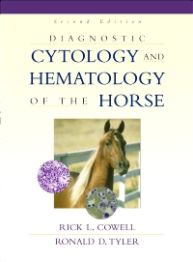Diagnostic Cytology and Hematology of the Horse, 2nd Edition
Date of Publication: 10/2001
Cytologic and hematologic evaluations are important primary diagnostic activities for veterinarians. Approximately 50% of samples are processed on site in the veterinary office; that number is growing, as veterinarians seek to bring more laboratory revenue to their practices. In doing so, however, it is important for veterinarians and staff to understand correct collection and handling procedures to avoid costly errors and make accurate diagnoses.
DIAGNOSTIC CYTOLOGY AND HEMATOLOGY OF THE HORSE is a practical reference that presents common clinical findings in an easy-to-use text/atlas format. Following a general chapter on sample collections and techniques, the remainder of the book takes a "systems" approach, followed by chapters on specific types of fluid. Within systems chapters, normal findings are presented first. Then, abnormal findings are presented by "class" of problems, such as bacterial lesions, fungal lesions, parasitic lesions, and so on, in the case of the eye. Algorithms (flow charts) on sample evaluations enhance text discussions by guiding readers to the most likely cytologic diagnosis. In addition, there is a colour plate section featuring 64 illustrations for quick viewing and comparing cell types and infectious agents. The detailed index will aid utilization of this edition as a quick photographic and textual reference.
DIAGNOSTIC CYTOLOGY AND HEMATOLOGY OF THE HORSE is a practical reference that presents common clinical findings in an easy-to-use text/atlas format. Following a general chapter on sample collections and techniques, the remainder of the book takes a "systems" approach, followed by chapters on specific types of fluid. Within systems chapters, normal findings are presented first. Then, abnormal findings are presented by "class" of problems, such as bacterial lesions, fungal lesions, parasitic lesions, and so on, in the case of the eye. Algorithms (flow charts) on sample evaluations enhance text discussions by guiding readers to the most likely cytologic diagnosis. In addition, there is a colour plate section featuring 64 illustrations for quick viewing and comparing cell types and infectious agents. The detailed index will aid utilization of this edition as a quick photographic and textual reference.
Cytologic and hematologic evaluations are important primary diagnostic activities for veterinarians. Approximately 50% of samples are processed on site in the veterinary office; that number is growing, as veterinarians seek to bring more laboratory revenue to their practices. In doing so, however, it is important for veterinarians and staff to understand correct collection and handling procedures to avoid costly errors and make accurate diagnoses.
DIAGNOSTIC CYTOLOGY AND HEMATOLOGY OF THE HORSE is a practical reference that presents common clinical findings in an easy-to-use text/atlas format. Following a general chapter on sample collections and techniques, the remainder of the book takes a "systems" approach, followed by chapters on specific types of fluid. Within systems chapters, normal findings are presented first. Then, abnormal findings are presented by "class" of problems, such as bacterial lesions, fungal lesions, parasitic lesions, and so on, in the case of the eye. Algorithms (flow charts) on sample evaluations enhance text discussions by guiding readers to the most likely cytologic diagnosis. In addition, there is a colour plate section featuring 64 illustrations for quick viewing and comparing cell types and infectious agents. The detailed index will aid utilization of this edition as a quick photographic and textual reference.
DIAGNOSTIC CYTOLOGY AND HEMATOLOGY OF THE HORSE is a practical reference that presents common clinical findings in an easy-to-use text/atlas format. Following a general chapter on sample collections and techniques, the remainder of the book takes a "systems" approach, followed by chapters on specific types of fluid. Within systems chapters, normal findings are presented first. Then, abnormal findings are presented by "class" of problems, such as bacterial lesions, fungal lesions, parasitic lesions, and so on, in the case of the eye. Algorithms (flow charts) on sample evaluations enhance text discussions by guiding readers to the most likely cytologic diagnosis. In addition, there is a colour plate section featuring 64 illustrations for quick viewing and comparing cell types and infectious agents. The detailed index will aid utilization of this edition as a quick photographic and textual reference.
New to this edition
Key Features
Author Information
By Rick L. Cowell, DVM, MS, MRCVS, DACVP, Veterinary Clinical Pathologist, IDEXX Laboratories, Inc., Stillwater, OK and Ronald D. Tyler, DVM, PhD, DACVP, DABT, Adjunct Professor, Department of Anatomy, Pathology, and Pharmacology, College of Veterinary Medicine, Oklahoma State University, Stillwater, OK











